Sustainability of the Fish Market in Australia
VerifiedAdded on 2023/06/07
|9
|2749
|65
AI Summary
This essay discusses the sustainability of the fish markets in Australia, including positive and negative aspects, decision making and implementation, and recommendations for preserving the ecosystem.
Contribute Materials
Your contribution can guide someone’s learning journey. Share your
documents today.
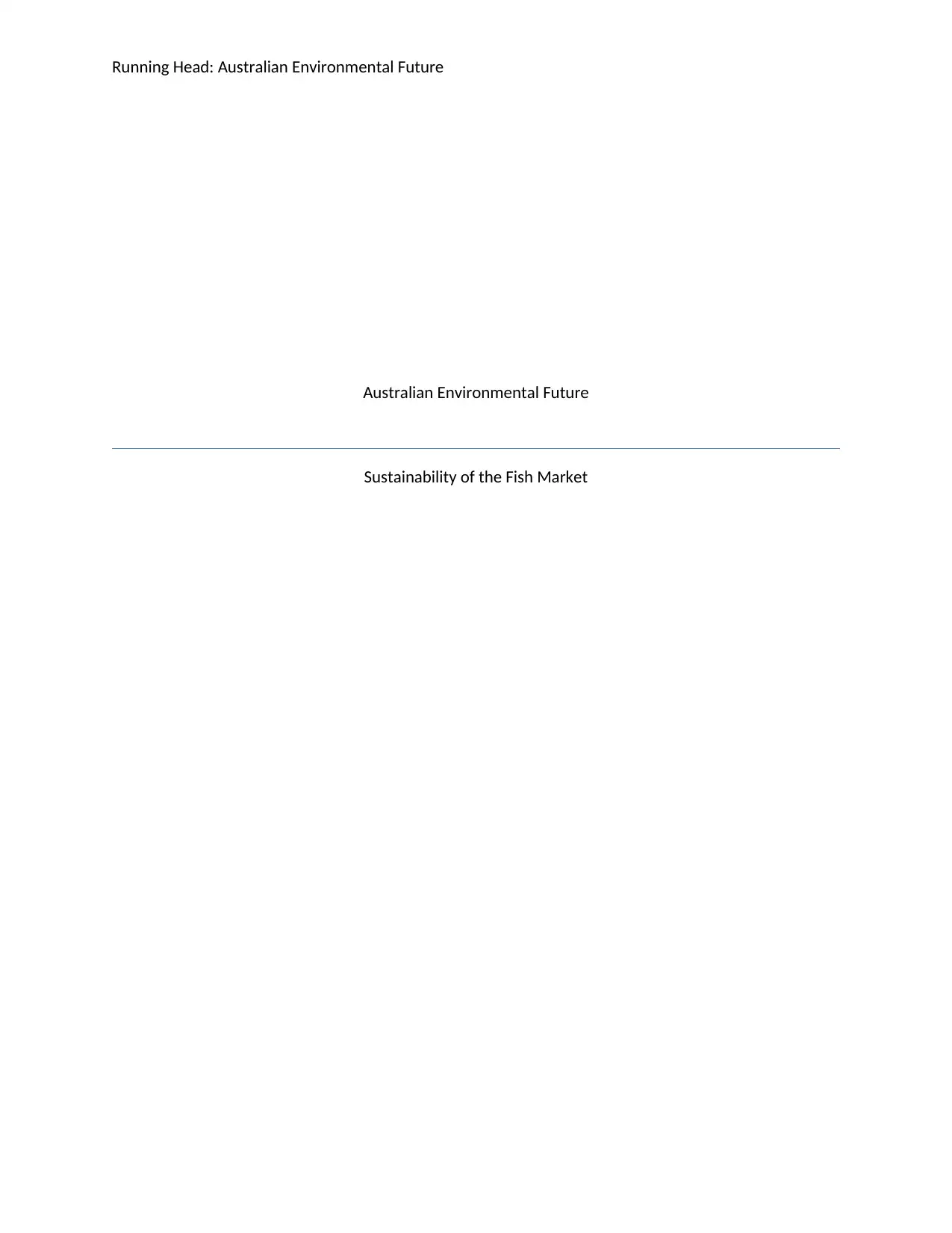
Running Head: Australian Environmental Future
Australian Environmental Future
Sustainability of the Fish Market
Australian Environmental Future
Sustainability of the Fish Market
Secure Best Marks with AI Grader
Need help grading? Try our AI Grader for instant feedback on your assignments.
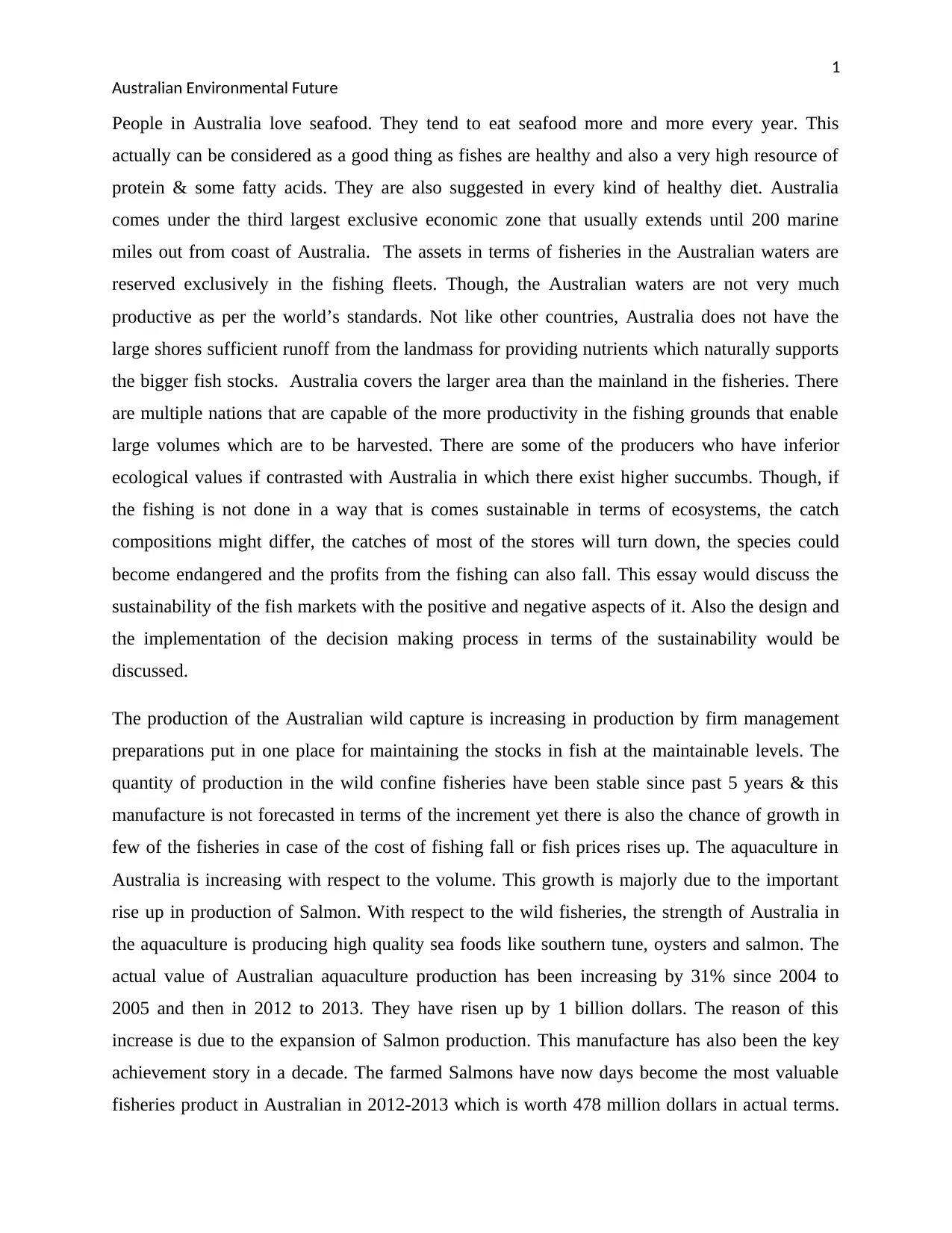
1
Australian Environmental Future
People in Australia love seafood. They tend to eat seafood more and more every year. This
actually can be considered as a good thing as fishes are healthy and also a very high resource of
protein & some fatty acids. They are also suggested in every kind of healthy diet. Australia
comes under the third largest exclusive economic zone that usually extends until 200 marine
miles out from coast of Australia. The assets in terms of fisheries in the Australian waters are
reserved exclusively in the fishing fleets. Though, the Australian waters are not very much
productive as per the world’s standards. Not like other countries, Australia does not have the
large shores sufficient runoff from the landmass for providing nutrients which naturally supports
the bigger fish stocks. Australia covers the larger area than the mainland in the fisheries. There
are multiple nations that are capable of the more productivity in the fishing grounds that enable
large volumes which are to be harvested. There are some of the producers who have inferior
ecological values if contrasted with Australia in which there exist higher succumbs. Though, if
the fishing is not done in a way that is comes sustainable in terms of ecosystems, the catch
compositions might differ, the catches of most of the stores will turn down, the species could
become endangered and the profits from the fishing can also fall. This essay would discuss the
sustainability of the fish markets with the positive and negative aspects of it. Also the design and
the implementation of the decision making process in terms of the sustainability would be
discussed.
The production of the Australian wild capture is increasing in production by firm management
preparations put in one place for maintaining the stocks in fish at the maintainable levels. The
quantity of production in the wild confine fisheries have been stable since past 5 years & this
manufacture is not forecasted in terms of the increment yet there is also the chance of growth in
few of the fisheries in case of the cost of fishing fall or fish prices rises up. The aquaculture in
Australia is increasing with respect to the volume. This growth is majorly due to the important
rise up in production of Salmon. With respect to the wild fisheries, the strength of Australia in
the aquaculture is producing high quality sea foods like southern tune, oysters and salmon. The
actual value of Australian aquaculture production has been increasing by 31% since 2004 to
2005 and then in 2012 to 2013. They have risen up by 1 billion dollars. The reason of this
increase is due to the expansion of Salmon production. This manufacture has also been the key
achievement story in a decade. The farmed Salmons have now days become the most valuable
fisheries product in Australian in 2012-2013 which is worth 478 million dollars in actual terms.
Australian Environmental Future
People in Australia love seafood. They tend to eat seafood more and more every year. This
actually can be considered as a good thing as fishes are healthy and also a very high resource of
protein & some fatty acids. They are also suggested in every kind of healthy diet. Australia
comes under the third largest exclusive economic zone that usually extends until 200 marine
miles out from coast of Australia. The assets in terms of fisheries in the Australian waters are
reserved exclusively in the fishing fleets. Though, the Australian waters are not very much
productive as per the world’s standards. Not like other countries, Australia does not have the
large shores sufficient runoff from the landmass for providing nutrients which naturally supports
the bigger fish stocks. Australia covers the larger area than the mainland in the fisheries. There
are multiple nations that are capable of the more productivity in the fishing grounds that enable
large volumes which are to be harvested. There are some of the producers who have inferior
ecological values if contrasted with Australia in which there exist higher succumbs. Though, if
the fishing is not done in a way that is comes sustainable in terms of ecosystems, the catch
compositions might differ, the catches of most of the stores will turn down, the species could
become endangered and the profits from the fishing can also fall. This essay would discuss the
sustainability of the fish markets with the positive and negative aspects of it. Also the design and
the implementation of the decision making process in terms of the sustainability would be
discussed.
The production of the Australian wild capture is increasing in production by firm management
preparations put in one place for maintaining the stocks in fish at the maintainable levels. The
quantity of production in the wild confine fisheries have been stable since past 5 years & this
manufacture is not forecasted in terms of the increment yet there is also the chance of growth in
few of the fisheries in case of the cost of fishing fall or fish prices rises up. The aquaculture in
Australia is increasing with respect to the volume. This growth is majorly due to the important
rise up in production of Salmon. With respect to the wild fisheries, the strength of Australia in
the aquaculture is producing high quality sea foods like southern tune, oysters and salmon. The
actual value of Australian aquaculture production has been increasing by 31% since 2004 to
2005 and then in 2012 to 2013. They have risen up by 1 billion dollars. The reason of this
increase is due to the expansion of Salmon production. This manufacture has also been the key
achievement story in a decade. The farmed Salmons have now days become the most valuable
fisheries product in Australian in 2012-2013 which is worth 478 million dollars in actual terms.
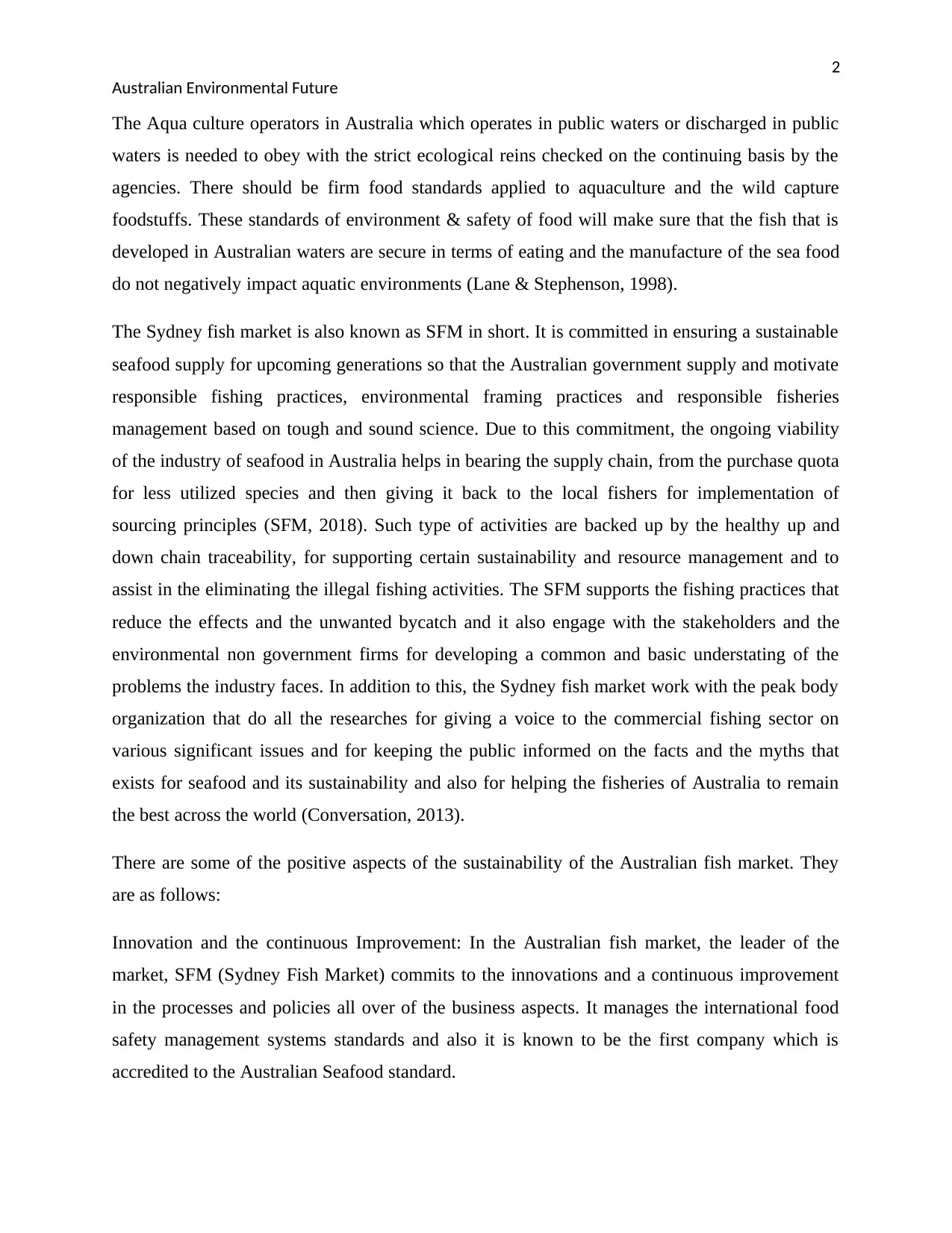
2
Australian Environmental Future
The Aqua culture operators in Australia which operates in public waters or discharged in public
waters is needed to obey with the strict ecological reins checked on the continuing basis by the
agencies. There should be firm food standards applied to aquaculture and the wild capture
foodstuffs. These standards of environment & safety of food will make sure that the fish that is
developed in Australian waters are secure in terms of eating and the manufacture of the sea food
do not negatively impact aquatic environments (Lane & Stephenson, 1998).
The Sydney fish market is also known as SFM in short. It is committed in ensuring a sustainable
seafood supply for upcoming generations so that the Australian government supply and motivate
responsible fishing practices, environmental framing practices and responsible fisheries
management based on tough and sound science. Due to this commitment, the ongoing viability
of the industry of seafood in Australia helps in bearing the supply chain, from the purchase quota
for less utilized species and then giving it back to the local fishers for implementation of
sourcing principles (SFM, 2018). Such type of activities are backed up by the healthy up and
down chain traceability, for supporting certain sustainability and resource management and to
assist in the eliminating the illegal fishing activities. The SFM supports the fishing practices that
reduce the effects and the unwanted bycatch and it also engage with the stakeholders and the
environmental non government firms for developing a common and basic understating of the
problems the industry faces. In addition to this, the Sydney fish market work with the peak body
organization that do all the researches for giving a voice to the commercial fishing sector on
various significant issues and for keeping the public informed on the facts and the myths that
exists for seafood and its sustainability and also for helping the fisheries of Australia to remain
the best across the world (Conversation, 2013).
There are some of the positive aspects of the sustainability of the Australian fish market. They
are as follows:
Innovation and the continuous Improvement: In the Australian fish market, the leader of the
market, SFM (Sydney Fish Market) commits to the innovations and a continuous improvement
in the processes and policies all over of the business aspects. It manages the international food
safety management systems standards and also it is known to be the first company which is
accredited to the Australian Seafood standard.
Australian Environmental Future
The Aqua culture operators in Australia which operates in public waters or discharged in public
waters is needed to obey with the strict ecological reins checked on the continuing basis by the
agencies. There should be firm food standards applied to aquaculture and the wild capture
foodstuffs. These standards of environment & safety of food will make sure that the fish that is
developed in Australian waters are secure in terms of eating and the manufacture of the sea food
do not negatively impact aquatic environments (Lane & Stephenson, 1998).
The Sydney fish market is also known as SFM in short. It is committed in ensuring a sustainable
seafood supply for upcoming generations so that the Australian government supply and motivate
responsible fishing practices, environmental framing practices and responsible fisheries
management based on tough and sound science. Due to this commitment, the ongoing viability
of the industry of seafood in Australia helps in bearing the supply chain, from the purchase quota
for less utilized species and then giving it back to the local fishers for implementation of
sourcing principles (SFM, 2018). Such type of activities are backed up by the healthy up and
down chain traceability, for supporting certain sustainability and resource management and to
assist in the eliminating the illegal fishing activities. The SFM supports the fishing practices that
reduce the effects and the unwanted bycatch and it also engage with the stakeholders and the
environmental non government firms for developing a common and basic understating of the
problems the industry faces. In addition to this, the Sydney fish market work with the peak body
organization that do all the researches for giving a voice to the commercial fishing sector on
various significant issues and for keeping the public informed on the facts and the myths that
exists for seafood and its sustainability and also for helping the fisheries of Australia to remain
the best across the world (Conversation, 2013).
There are some of the positive aspects of the sustainability of the Australian fish market. They
are as follows:
Innovation and the continuous Improvement: In the Australian fish market, the leader of the
market, SFM (Sydney Fish Market) commits to the innovations and a continuous improvement
in the processes and policies all over of the business aspects. It manages the international food
safety management systems standards and also it is known to be the first company which is
accredited to the Australian Seafood standard.
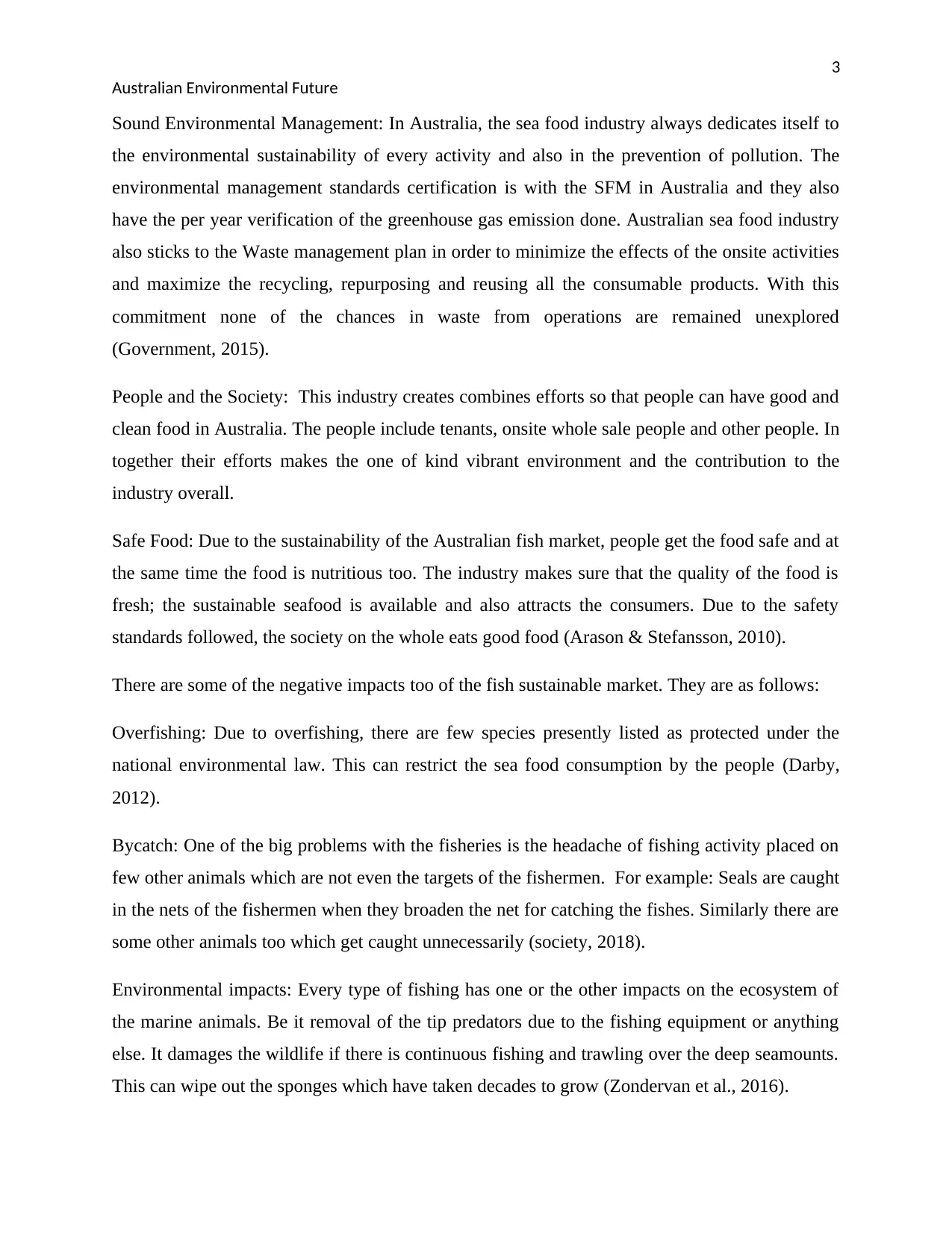
3
Australian Environmental Future
Sound Environmental Management: In Australia, the sea food industry always dedicates itself to
the environmental sustainability of every activity and also in the prevention of pollution. The
environmental management standards certification is with the SFM in Australia and they also
have the per year verification of the greenhouse gas emission done. Australian sea food industry
also sticks to the Waste management plan in order to minimize the effects of the onsite activities
and maximize the recycling, repurposing and reusing all the consumable products. With this
commitment none of the chances in waste from operations are remained unexplored
(Government, 2015).
People and the Society: This industry creates combines efforts so that people can have good and
clean food in Australia. The people include tenants, onsite whole sale people and other people. In
together their efforts makes the one of kind vibrant environment and the contribution to the
industry overall.
Safe Food: Due to the sustainability of the Australian fish market, people get the food safe and at
the same time the food is nutritious too. The industry makes sure that the quality of the food is
fresh; the sustainable seafood is available and also attracts the consumers. Due to the safety
standards followed, the society on the whole eats good food (Arason & Stefansson, 2010).
There are some of the negative impacts too of the fish sustainable market. They are as follows:
Overfishing: Due to overfishing, there are few species presently listed as protected under the
national environmental law. This can restrict the sea food consumption by the people (Darby,
2012).
Bycatch: One of the big problems with the fisheries is the headache of fishing activity placed on
few other animals which are not even the targets of the fishermen. For example: Seals are caught
in the nets of the fishermen when they broaden the net for catching the fishes. Similarly there are
some other animals too which get caught unnecessarily (society, 2018).
Environmental impacts: Every type of fishing has one or the other impacts on the ecosystem of
the marine animals. Be it removal of the tip predators due to the fishing equipment or anything
else. It damages the wildlife if there is continuous fishing and trawling over the deep seamounts.
This can wipe out the sponges which have taken decades to grow (Zondervan et al., 2016).
Australian Environmental Future
Sound Environmental Management: In Australia, the sea food industry always dedicates itself to
the environmental sustainability of every activity and also in the prevention of pollution. The
environmental management standards certification is with the SFM in Australia and they also
have the per year verification of the greenhouse gas emission done. Australian sea food industry
also sticks to the Waste management plan in order to minimize the effects of the onsite activities
and maximize the recycling, repurposing and reusing all the consumable products. With this
commitment none of the chances in waste from operations are remained unexplored
(Government, 2015).
People and the Society: This industry creates combines efforts so that people can have good and
clean food in Australia. The people include tenants, onsite whole sale people and other people. In
together their efforts makes the one of kind vibrant environment and the contribution to the
industry overall.
Safe Food: Due to the sustainability of the Australian fish market, people get the food safe and at
the same time the food is nutritious too. The industry makes sure that the quality of the food is
fresh; the sustainable seafood is available and also attracts the consumers. Due to the safety
standards followed, the society on the whole eats good food (Arason & Stefansson, 2010).
There are some of the negative impacts too of the fish sustainable market. They are as follows:
Overfishing: Due to overfishing, there are few species presently listed as protected under the
national environmental law. This can restrict the sea food consumption by the people (Darby,
2012).
Bycatch: One of the big problems with the fisheries is the headache of fishing activity placed on
few other animals which are not even the targets of the fishermen. For example: Seals are caught
in the nets of the fishermen when they broaden the net for catching the fishes. Similarly there are
some other animals too which get caught unnecessarily (society, 2018).
Environmental impacts: Every type of fishing has one or the other impacts on the ecosystem of
the marine animals. Be it removal of the tip predators due to the fishing equipment or anything
else. It damages the wildlife if there is continuous fishing and trawling over the deep seamounts.
This can wipe out the sponges which have taken decades to grow (Zondervan et al., 2016).
Secure Best Marks with AI Grader
Need help grading? Try our AI Grader for instant feedback on your assignments.
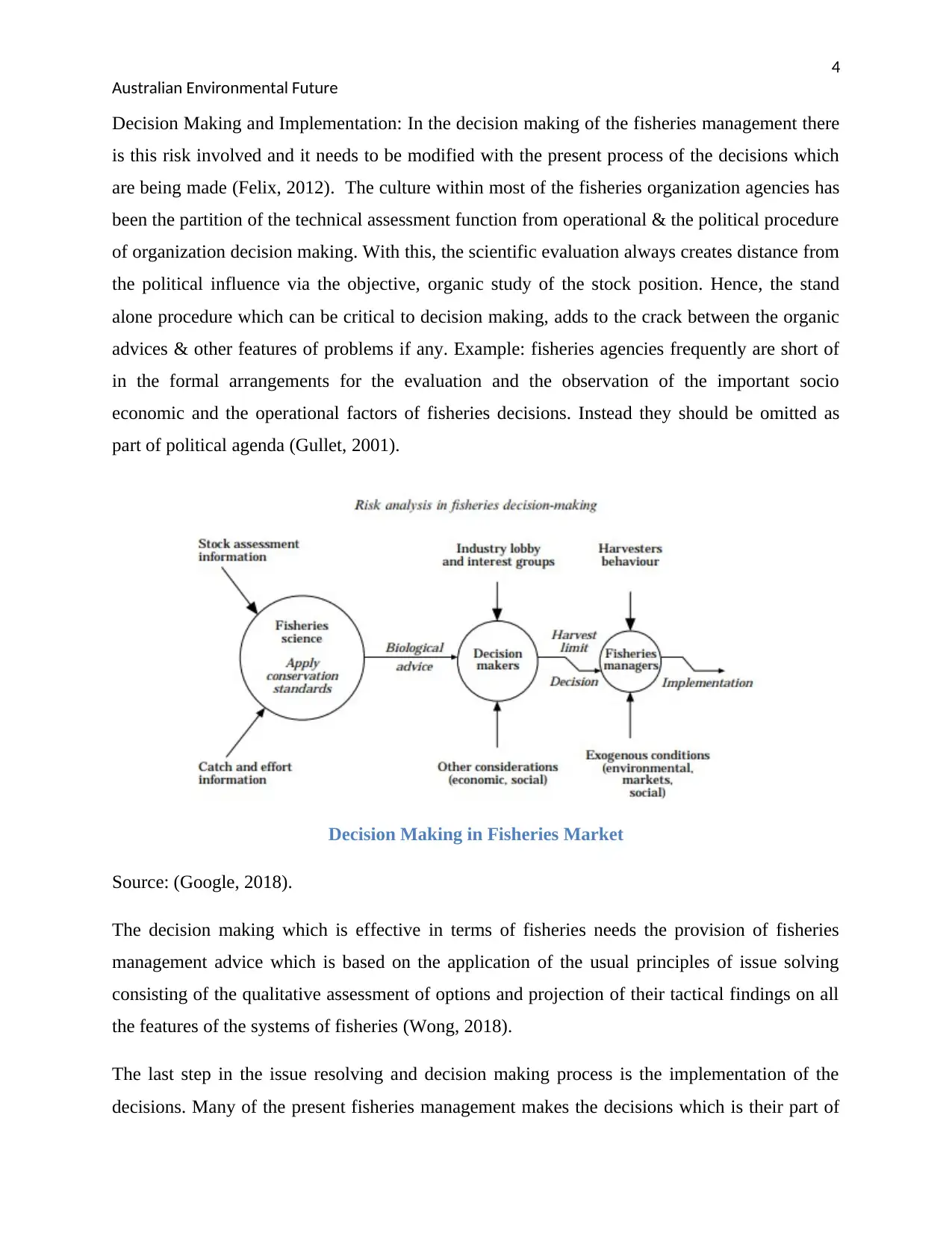
4
Australian Environmental Future
Decision Making and Implementation: In the decision making of the fisheries management there
is this risk involved and it needs to be modified with the present process of the decisions which
are being made (Felix, 2012). The culture within most of the fisheries organization agencies has
been the partition of the technical assessment function from operational & the political procedure
of organization decision making. With this, the scientific evaluation always creates distance from
the political influence via the objective, organic study of the stock position. Hence, the stand
alone procedure which can be critical to decision making, adds to the crack between the organic
advices & other features of problems if any. Example: fisheries agencies frequently are short of
in the formal arrangements for the evaluation and the observation of the important socio
economic and the operational factors of fisheries decisions. Instead they should be omitted as
part of political agenda (Gullet, 2001).
Decision Making in Fisheries Market
Source: (Google, 2018).
The decision making which is effective in terms of fisheries needs the provision of fisheries
management advice which is based on the application of the usual principles of issue solving
consisting of the qualitative assessment of options and projection of their tactical findings on all
the features of the systems of fisheries (Wong, 2018).
The last step in the issue resolving and decision making process is the implementation of the
decisions. Many of the present fisheries management makes the decisions which is their part of
Australian Environmental Future
Decision Making and Implementation: In the decision making of the fisheries management there
is this risk involved and it needs to be modified with the present process of the decisions which
are being made (Felix, 2012). The culture within most of the fisheries organization agencies has
been the partition of the technical assessment function from operational & the political procedure
of organization decision making. With this, the scientific evaluation always creates distance from
the political influence via the objective, organic study of the stock position. Hence, the stand
alone procedure which can be critical to decision making, adds to the crack between the organic
advices & other features of problems if any. Example: fisheries agencies frequently are short of
in the formal arrangements for the evaluation and the observation of the important socio
economic and the operational factors of fisheries decisions. Instead they should be omitted as
part of political agenda (Gullet, 2001).
Decision Making in Fisheries Market
Source: (Google, 2018).
The decision making which is effective in terms of fisheries needs the provision of fisheries
management advice which is based on the application of the usual principles of issue solving
consisting of the qualitative assessment of options and projection of their tactical findings on all
the features of the systems of fisheries (Wong, 2018).
The last step in the issue resolving and decision making process is the implementation of the
decisions. Many of the present fisheries management makes the decisions which is their part of
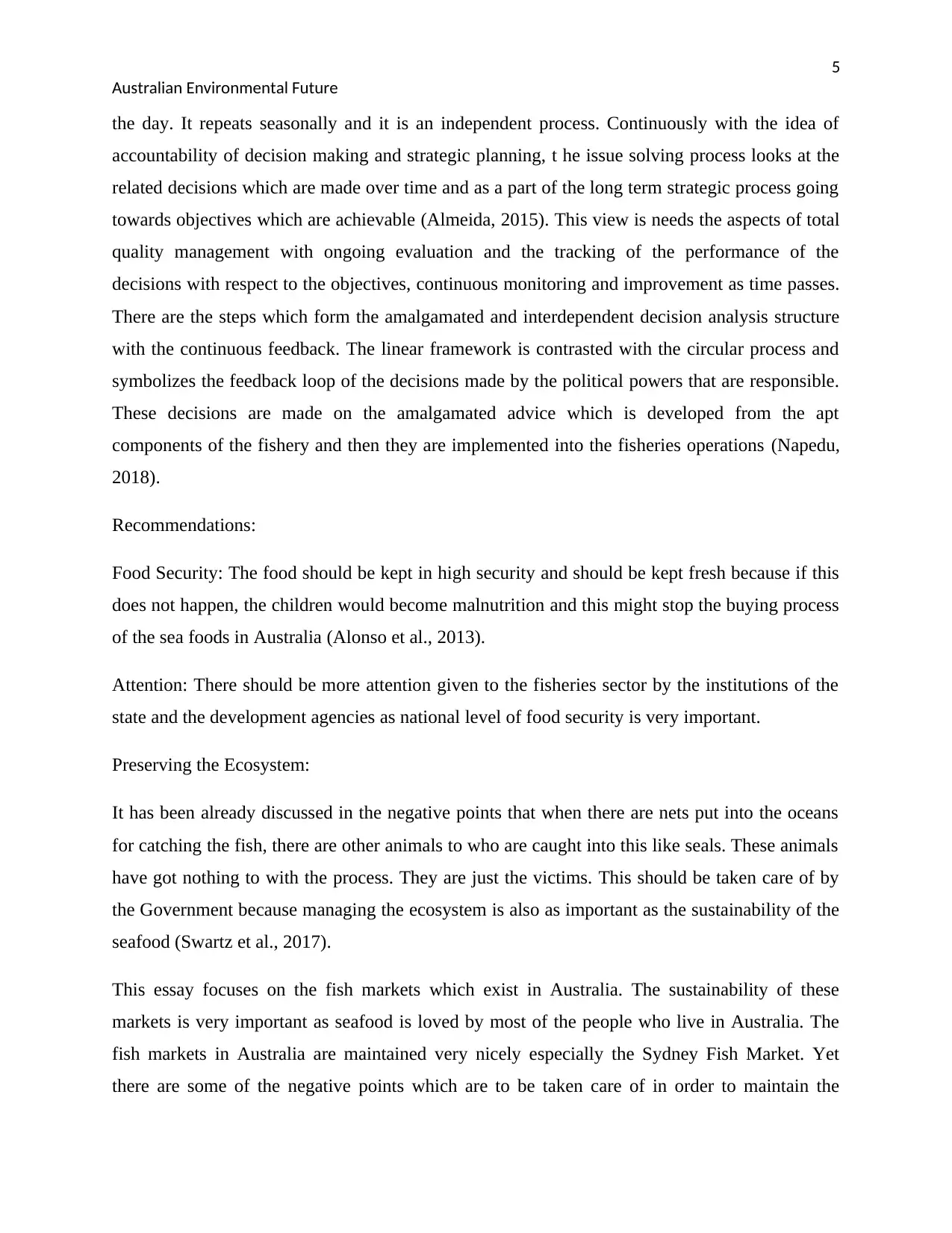
5
Australian Environmental Future
the day. It repeats seasonally and it is an independent process. Continuously with the idea of
accountability of decision making and strategic planning, t he issue solving process looks at the
related decisions which are made over time and as a part of the long term strategic process going
towards objectives which are achievable (Almeida, 2015). This view is needs the aspects of total
quality management with ongoing evaluation and the tracking of the performance of the
decisions with respect to the objectives, continuous monitoring and improvement as time passes.
There are the steps which form the amalgamated and interdependent decision analysis structure
with the continuous feedback. The linear framework is contrasted with the circular process and
symbolizes the feedback loop of the decisions made by the political powers that are responsible.
These decisions are made on the amalgamated advice which is developed from the apt
components of the fishery and then they are implemented into the fisheries operations (Napedu,
2018).
Recommendations:
Food Security: The food should be kept in high security and should be kept fresh because if this
does not happen, the children would become malnutrition and this might stop the buying process
of the sea foods in Australia (Alonso et al., 2013).
Attention: There should be more attention given to the fisheries sector by the institutions of the
state and the development agencies as national level of food security is very important.
Preserving the Ecosystem:
It has been already discussed in the negative points that when there are nets put into the oceans
for catching the fish, there are other animals to who are caught into this like seals. These animals
have got nothing to with the process. They are just the victims. This should be taken care of by
the Government because managing the ecosystem is also as important as the sustainability of the
seafood (Swartz et al., 2017).
This essay focuses on the fish markets which exist in Australia. The sustainability of these
markets is very important as seafood is loved by most of the people who live in Australia. The
fish markets in Australia are maintained very nicely especially the Sydney Fish Market. Yet
there are some of the negative points which are to be taken care of in order to maintain the
Australian Environmental Future
the day. It repeats seasonally and it is an independent process. Continuously with the idea of
accountability of decision making and strategic planning, t he issue solving process looks at the
related decisions which are made over time and as a part of the long term strategic process going
towards objectives which are achievable (Almeida, 2015). This view is needs the aspects of total
quality management with ongoing evaluation and the tracking of the performance of the
decisions with respect to the objectives, continuous monitoring and improvement as time passes.
There are the steps which form the amalgamated and interdependent decision analysis structure
with the continuous feedback. The linear framework is contrasted with the circular process and
symbolizes the feedback loop of the decisions made by the political powers that are responsible.
These decisions are made on the amalgamated advice which is developed from the apt
components of the fishery and then they are implemented into the fisheries operations (Napedu,
2018).
Recommendations:
Food Security: The food should be kept in high security and should be kept fresh because if this
does not happen, the children would become malnutrition and this might stop the buying process
of the sea foods in Australia (Alonso et al., 2013).
Attention: There should be more attention given to the fisheries sector by the institutions of the
state and the development agencies as national level of food security is very important.
Preserving the Ecosystem:
It has been already discussed in the negative points that when there are nets put into the oceans
for catching the fish, there are other animals to who are caught into this like seals. These animals
have got nothing to with the process. They are just the victims. This should be taken care of by
the Government because managing the ecosystem is also as important as the sustainability of the
seafood (Swartz et al., 2017).
This essay focuses on the fish markets which exist in Australia. The sustainability of these
markets is very important as seafood is loved by most of the people who live in Australia. The
fish markets in Australia are maintained very nicely especially the Sydney Fish Market. Yet
there are some of the negative points which are to be taken care of in order to maintain the
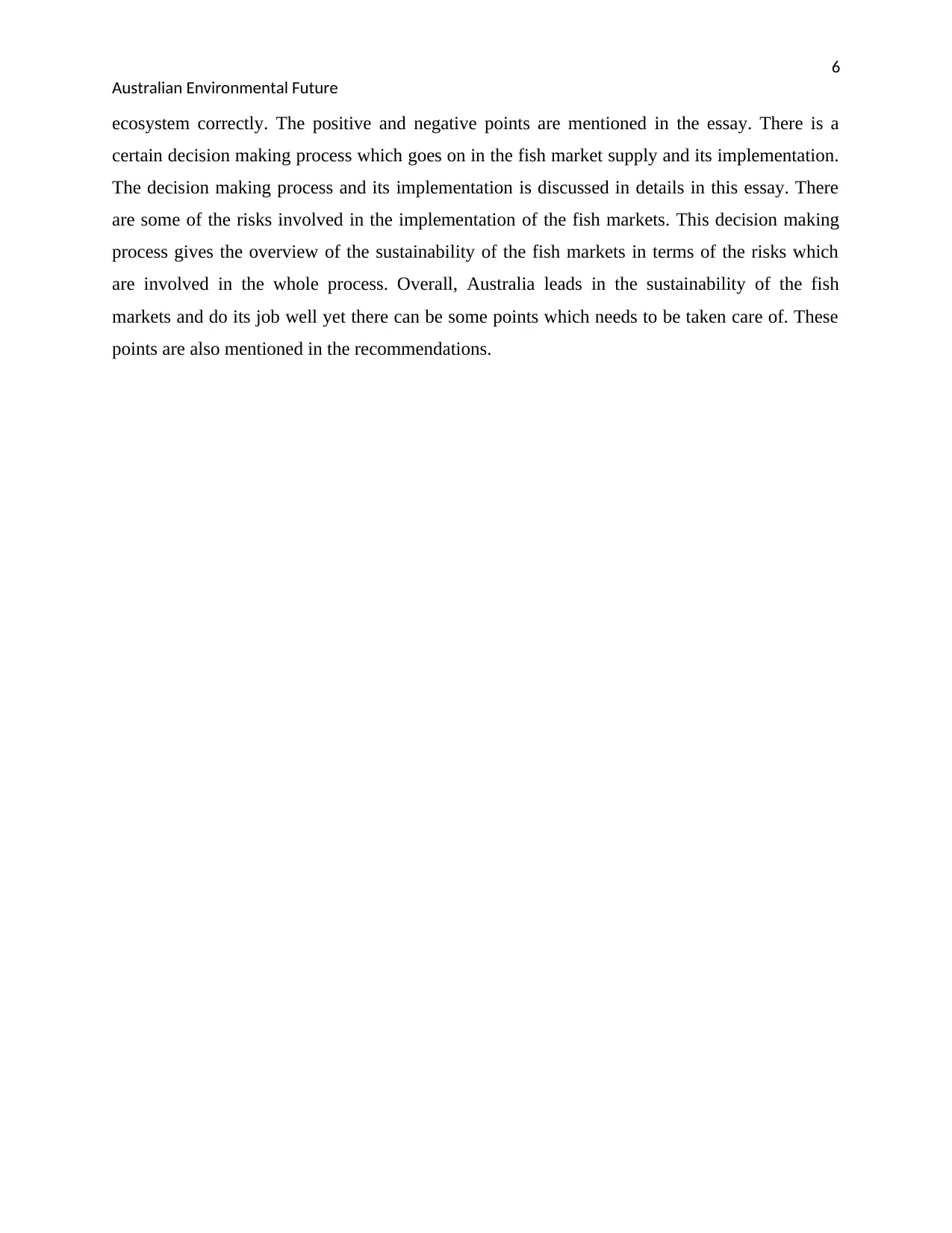
6
Australian Environmental Future
ecosystem correctly. The positive and negative points are mentioned in the essay. There is a
certain decision making process which goes on in the fish market supply and its implementation.
The decision making process and its implementation is discussed in details in this essay. There
are some of the risks involved in the implementation of the fish markets. This decision making
process gives the overview of the sustainability of the fish markets in terms of the risks which
are involved in the whole process. Overall, Australia leads in the sustainability of the fish
markets and do its job well yet there can be some points which needs to be taken care of. These
points are also mentioned in the recommendations.
Australian Environmental Future
ecosystem correctly. The positive and negative points are mentioned in the essay. There is a
certain decision making process which goes on in the fish market supply and its implementation.
The decision making process and its implementation is discussed in details in this essay. There
are some of the risks involved in the implementation of the fish markets. This decision making
process gives the overview of the sustainability of the fish markets in terms of the risks which
are involved in the whole process. Overall, Australia leads in the sustainability of the fish
markets and do its job well yet there can be some points which needs to be taken care of. These
points are also mentioned in the recommendations.
Paraphrase This Document
Need a fresh take? Get an instant paraphrase of this document with our AI Paraphraser
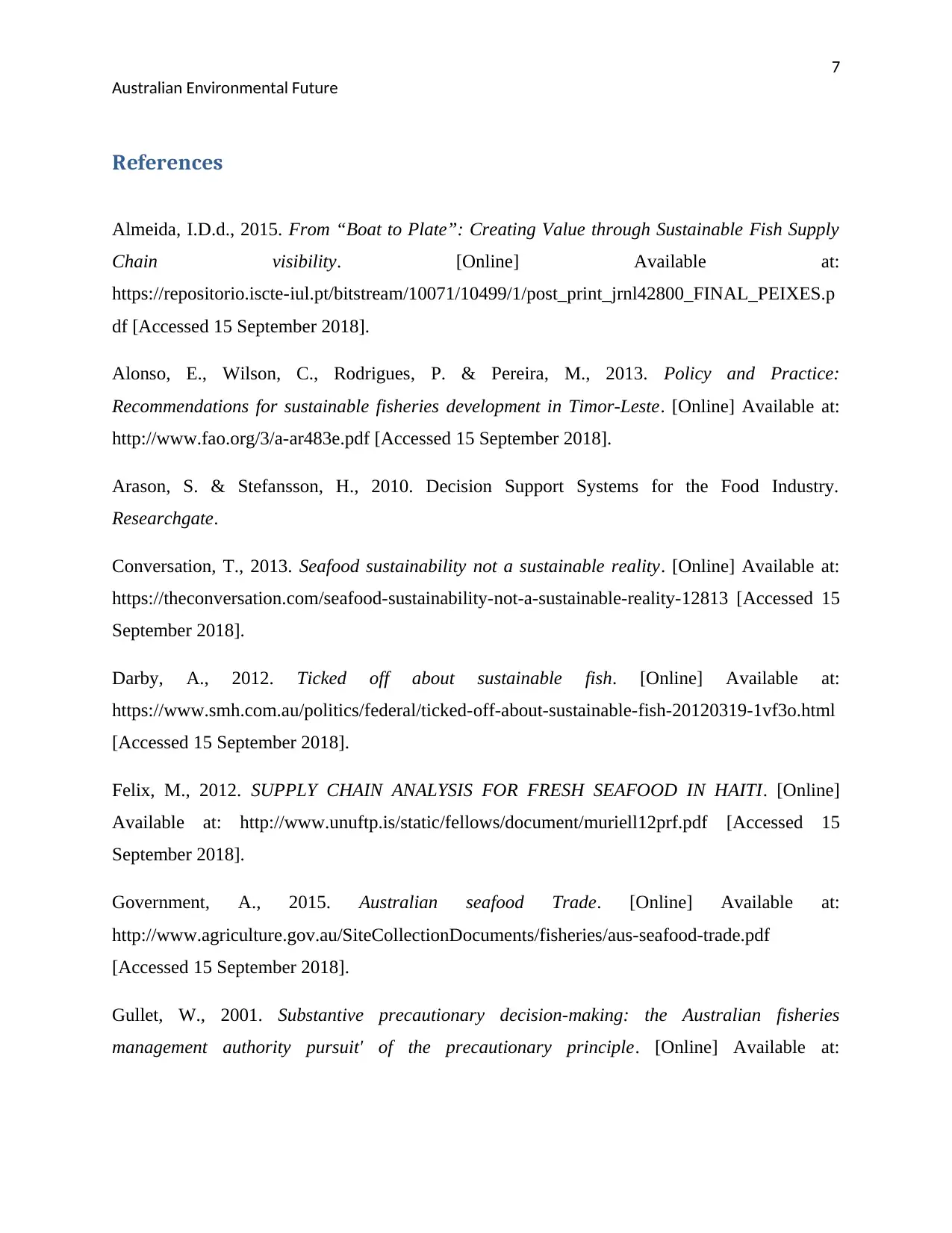
7
Australian Environmental Future
References
Almeida, I.D.d., 2015. From “Boat to Plate”: Creating Value through Sustainable Fish Supply
Chain visibility. [Online] Available at:
https://repositorio.iscte-iul.pt/bitstream/10071/10499/1/post_print_jrnl42800_FINAL_PEIXES.p
df [Accessed 15 September 2018].
Alonso, E., Wilson, C., Rodrigues, P. & Pereira, M., 2013. Policy and Practice:
Recommendations for sustainable fisheries development in Timor-Leste. [Online] Available at:
http://www.fao.org/3/a-ar483e.pdf [Accessed 15 September 2018].
Arason, S. & Stefansson, H., 2010. Decision Support Systems for the Food Industry.
Researchgate.
Conversation, T., 2013. Seafood sustainability not a sustainable reality. [Online] Available at:
https://theconversation.com/seafood-sustainability-not-a-sustainable-reality-12813 [Accessed 15
September 2018].
Darby, A., 2012. Ticked off about sustainable fish. [Online] Available at:
https://www.smh.com.au/politics/federal/ticked-off-about-sustainable-fish-20120319-1vf3o.html
[Accessed 15 September 2018].
Felix, M., 2012. SUPPLY CHAIN ANALYSIS FOR FRESH SEAFOOD IN HAITI. [Online]
Available at: http://www.unuftp.is/static/fellows/document/muriell12prf.pdf [Accessed 15
September 2018].
Government, A., 2015. Australian seafood Trade. [Online] Available at:
http://www.agriculture.gov.au/SiteCollectionDocuments/fisheries/aus-seafood-trade.pdf
[Accessed 15 September 2018].
Gullet, W., 2001. Substantive precautionary decision-making: the Australian fisheries
management authority pursuit' of the precautionary principle. [Online] Available at:
Australian Environmental Future
References
Almeida, I.D.d., 2015. From “Boat to Plate”: Creating Value through Sustainable Fish Supply
Chain visibility. [Online] Available at:
https://repositorio.iscte-iul.pt/bitstream/10071/10499/1/post_print_jrnl42800_FINAL_PEIXES.p
df [Accessed 15 September 2018].
Alonso, E., Wilson, C., Rodrigues, P. & Pereira, M., 2013. Policy and Practice:
Recommendations for sustainable fisheries development in Timor-Leste. [Online] Available at:
http://www.fao.org/3/a-ar483e.pdf [Accessed 15 September 2018].
Arason, S. & Stefansson, H., 2010. Decision Support Systems for the Food Industry.
Researchgate.
Conversation, T., 2013. Seafood sustainability not a sustainable reality. [Online] Available at:
https://theconversation.com/seafood-sustainability-not-a-sustainable-reality-12813 [Accessed 15
September 2018].
Darby, A., 2012. Ticked off about sustainable fish. [Online] Available at:
https://www.smh.com.au/politics/federal/ticked-off-about-sustainable-fish-20120319-1vf3o.html
[Accessed 15 September 2018].
Felix, M., 2012. SUPPLY CHAIN ANALYSIS FOR FRESH SEAFOOD IN HAITI. [Online]
Available at: http://www.unuftp.is/static/fellows/document/muriell12prf.pdf [Accessed 15
September 2018].
Government, A., 2015. Australian seafood Trade. [Online] Available at:
http://www.agriculture.gov.au/SiteCollectionDocuments/fisheries/aus-seafood-trade.pdf
[Accessed 15 September 2018].
Gullet, W., 2001. Substantive precautionary decision-making: the Australian fisheries
management authority pursuit' of the precautionary principle. [Online] Available at:
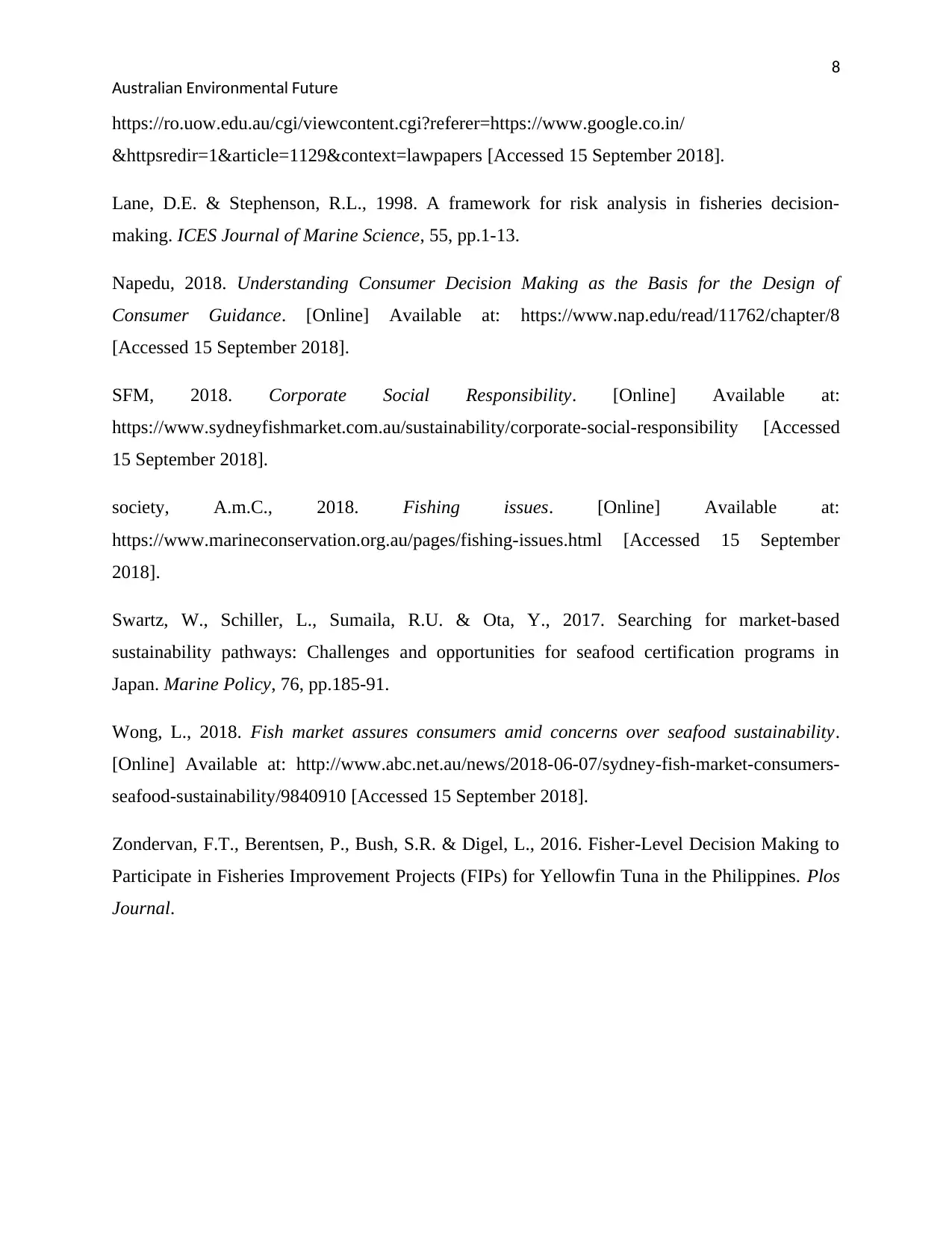
8
Australian Environmental Future
https://ro.uow.edu.au/cgi/viewcontent.cgi?referer=https://www.google.co.in/
&httpsredir=1&article=1129&context=lawpapers [Accessed 15 September 2018].
Lane, D.E. & Stephenson, R.L., 1998. A framework for risk analysis in fisheries decision-
making. ICES Journal of Marine Science, 55, pp.1-13.
Napedu, 2018. Understanding Consumer Decision Making as the Basis for the Design of
Consumer Guidance. [Online] Available at: https://www.nap.edu/read/11762/chapter/8
[Accessed 15 September 2018].
SFM, 2018. Corporate Social Responsibility. [Online] Available at:
https://www.sydneyfishmarket.com.au/sustainability/corporate-social-responsibility [Accessed
15 September 2018].
society, A.m.C., 2018. Fishing issues. [Online] Available at:
https://www.marineconservation.org.au/pages/fishing-issues.html [Accessed 15 September
2018].
Swartz, W., Schiller, L., Sumaila, R.U. & Ota, Y., 2017. Searching for market-based
sustainability pathways: Challenges and opportunities for seafood certification programs in
Japan. Marine Policy, 76, pp.185-91.
Wong, L., 2018. Fish market assures consumers amid concerns over seafood sustainability.
[Online] Available at: http://www.abc.net.au/news/2018-06-07/sydney-fish-market-consumers-
seafood-sustainability/9840910 [Accessed 15 September 2018].
Zondervan, F.T., Berentsen, P., Bush, S.R. & Digel, L., 2016. Fisher-Level Decision Making to
Participate in Fisheries Improvement Projects (FIPs) for Yellowfin Tuna in the Philippines. Plos
Journal.
Australian Environmental Future
https://ro.uow.edu.au/cgi/viewcontent.cgi?referer=https://www.google.co.in/
&httpsredir=1&article=1129&context=lawpapers [Accessed 15 September 2018].
Lane, D.E. & Stephenson, R.L., 1998. A framework for risk analysis in fisheries decision-
making. ICES Journal of Marine Science, 55, pp.1-13.
Napedu, 2018. Understanding Consumer Decision Making as the Basis for the Design of
Consumer Guidance. [Online] Available at: https://www.nap.edu/read/11762/chapter/8
[Accessed 15 September 2018].
SFM, 2018. Corporate Social Responsibility. [Online] Available at:
https://www.sydneyfishmarket.com.au/sustainability/corporate-social-responsibility [Accessed
15 September 2018].
society, A.m.C., 2018. Fishing issues. [Online] Available at:
https://www.marineconservation.org.au/pages/fishing-issues.html [Accessed 15 September
2018].
Swartz, W., Schiller, L., Sumaila, R.U. & Ota, Y., 2017. Searching for market-based
sustainability pathways: Challenges and opportunities for seafood certification programs in
Japan. Marine Policy, 76, pp.185-91.
Wong, L., 2018. Fish market assures consumers amid concerns over seafood sustainability.
[Online] Available at: http://www.abc.net.au/news/2018-06-07/sydney-fish-market-consumers-
seafood-sustainability/9840910 [Accessed 15 September 2018].
Zondervan, F.T., Berentsen, P., Bush, S.R. & Digel, L., 2016. Fisher-Level Decision Making to
Participate in Fisheries Improvement Projects (FIPs) for Yellowfin Tuna in the Philippines. Plos
Journal.
1 out of 9
Related Documents
Your All-in-One AI-Powered Toolkit for Academic Success.
+13062052269
info@desklib.com
Available 24*7 on WhatsApp / Email
![[object Object]](/_next/static/media/star-bottom.7253800d.svg)
Unlock your academic potential
© 2024 | Zucol Services PVT LTD | All rights reserved.





